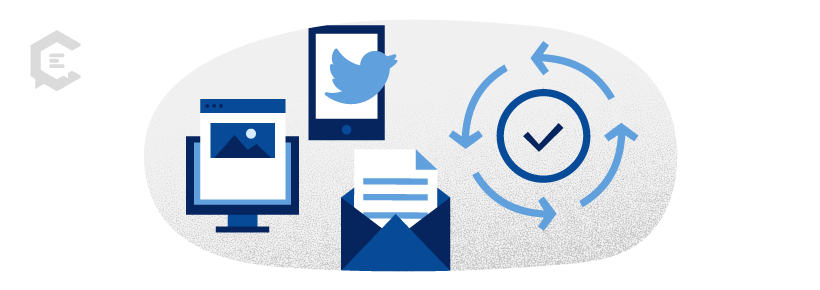You sit down for a quick scrum with your content operations team, then float the question, “What drives our content strategy?” Would everyone’s answers align?
If not, calibrating your team’s compass may be easier than you think; using customer experience goals as your due North is key.
This article explores the intricate link between content operations and customer satisfaction, uncovering strategies to align content with customer experience goals.

The Link Between Content Operations and Customer Satisfaction
Linking content operations and your customers’ journeys starts with understanding each customer’s story and then personalizing content to maximize its relevance.
Understanding the customer journey
At the heart of content operations lies a profound understanding of the customer journey. Mapping content to different stages of this journey is crucial. Whether creating awareness, driving consideration, or fostering loyalty, content must resonate with the audience’s needs and expectations at every touchpoint.
For example, suppose you have a few newly converted customers and want to move them through to the loyalty phase of their customer journey. This may begin with asking. “What kinds of content can we create to make them both return and rave?” Depending on your product or service, you may provide them with:
- Tutorials that make your product easier to use
- Emails about features that make their specific workflows more efficient
- If you provide a subscription-based service, ways they can realize a higher ROI without having to upgrade to a higher-level package
Content personalization and relevance
Organizations can personalize their content by leveraging data and analytics, ensuring it’s relevant to the customer’s experience.
For example, let’s say you run an email marketing campaign for new leads, and the email contains a link to a product description page. By studying your site analytics, you can see how many go to that page and how long they stay. If the page has a high bounce rate, it’s safe to assume customers aren’t seeing what they want when they arrive. So you may want to:
- Include more images
- Provide specifications and product details above the page’s first fold
- Include pricing options instead of forcing customers to call, fill out a form, or email to get a price
This way, you make your content more relevant to people who want more information or need pricing data before taking the next step.
On the other hand, for some products or services, your page analytics may reveal that you’re providing too much info. For instance, if you provide a ton of info about a single product, the content may take up the entire first fold. Your analytics may reveal that leads aren’t clicking on anything beneath that first fold — even though there are relevant products farther down. Using this data, you could put more products above the first fold, using less detailed information for each one.
The best way to know which avenue to take is to use data to guide your personalization and relevance decisions.
Best Practices for Aligning Content with Customer Experience Goals
By using the following best practices, you can streamline the process of aligning your content with each customer’s experience.
Gathering and utilizing customer feedback
Customer feedback is packed full of insights for your content operations team. Therefore, you should actively seek out then analyze feedback, asking:
- Which feedback do we see repeating?
- If we had to choose one element to change based on feedback, which would give us the highest return on the resources used?
- Can we diversify our self-help and troubleshooting content to prevent some of the negative feedback we’re getting?
By incorporating feedback into your content strategy, you can continually refine your approach and stay attuned to evolving customer expectations.
Integrating storytelling and emotional connection
Content operations should focus on weaving narratives that resonate with the audience on a deeper level, fostering emotional connections that transcend the transactional nature of business.
This may involve going beyond the standard pain point/solution storytelling format. For many companies, this may simply be a matter of getting more specific regarding the kind of pain points the customer may be experiencing. For example, suppose you provide software that helps manufacturers streamline their operations.
Instead of creating content about the general value of automating data entry or integrating disparate applications, you can get more specific. You could produce articles about ways to use your software to insulate customers’ operations from supply chain fluctuations, automatically identifying alternate procurement options during delays. This way, you align your content with addressing a specific — and incredibly frustrating — challenge.
Consistency across channels
Content operations must ensure a unified experience across all touchpoints — website, social media, email, or in-person interactions. Consistent messaging and branding build trust and reinforce the brand identity in the minds of consumers.
One of the easiest ways to maintain consistency is to create multi-purpose content that works on more than one channel. This may involve:
- Straightforward infographics with relatively large fonts that are easily legible on mobile devices
- Content on your site customers can click on regardless of whether they use email or a range of social media outlets
- Brief summations of white papers that both create interest in the piece and give readers actionable information
Balancing Business Objectives with Customer Needs
While content operations are instrumental in shaping customer experiences, a delicate balance must be struck between achieving business objectives and meeting customer needs. Recognizing that content should not be solely focused on sales pitches but should add value to the customer journey is essential. Striking this equilibrium requires a deep understanding of business goals and customer interests.
Measuring Impact and Adjusting Strategies
Effectively navigating the intersection of content and customer experience involves continuous measurement and adjustment. Leveraging analytics tools to track content performance and customer responses provides invaluable insights. By understanding what content resonates with the audience, you can refine your strategies, ensuring that your content not only aligns with business goals but also meets your customers’ evolving expectations.
How to measure impact and make adjustments
Suppose a company launches a social media campaign. It features a mix of videos, infographics, and blog posts. The marketing team can gauge the audience’s response by closely monitoring likes, shares, comments, and overall engagement. Let’s say some videos receive higher engagement than others. The team can then analyze the high-performing videos and pinpoint their commonalities. Once they isolate the most appealing traits of the high-performing videos, the team can use these as foundations for creating another wave of successful videos.
Tools for measuring the impact of content on the customer experience
While there are a number of tools on the market that make it easier to figure out how your content is affecting your customers’ experiences, here are two that marketers often find especially effective:
Google Analytics
Google Analytics helps businesses track website traffic and user behavior. As such, it’s a valuable tool for quantifying content performance. Companies can understand how customers interact with the content they generate by examining metrics such as bounce rates, time spent on pages, and conversion rates.
Social media analytics
Platforms like Facebook Insights, Twitter Analytics, and Instagram Insights offer detailed data on your content’s performance. They can give you data regarding audience demographics, engagement, and who your content is reaching. Businesses can use this data to refine their content strategies, tailoring their creative decisions to the preferences of their audience.
How can you tell how content is influencing the customer experience?
Understanding how content impacts customer response and experience involves focusing on customers’:
- Customers’ emotional connection with the content. Analyze comments, sentiment analysis, and feedback. This makes it easier to understand whether the content resonates positively or if you have to make some adjustments to align it with your brand’s desired emotional impact.
- The experiences users have while interacting with your content. Content extends to website design, navigation, and overall user experience. Using tools like heatmaps and session recordings, you can better understand how users interact with your website. The data you glean can make it easier to identify pain points and enhance the overall user experience.
Unify Your Marketing by Aligning Content Ops and CX
Integrating content operations into the customer experience strategy is not just a trend; it’s a necessity. Organizations prioritizing this integration are better positioned to create meaningful engagements, foster customer loyalty, and ultimately outpace their competitors. As the digital landscape evolves, the seamless fusion of content and customer experience will remain a key driver of success.
Ready to elevate your content operations and enhance customer experiences? Explore how ClearVoice can help. And if you’re looking for personalized insights to boost your content strategy, you can speak with one of our content specialists today.







